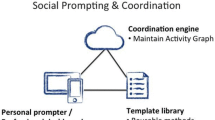Abstract
This chapter describes techniques to incorporate richer models of social behavior into deliberative planning agents, providing them the capability to obey organizational constraints and engage in self-interested and collaborative behavior in the context of virtual training environments.
USC Institute for Creative Technologies
Access this chapter
Tax calculation will be finalised at checkout
Purchases are for personal use only
Preview
Unable to display preview. Download preview PDF.
Similar content being viewed by others
References
J. Gratch. Emile: Marshalling passions in training and education. In Proceedings of the Fourth International Conference on Autonomous Agents, pages 325–332, New York, 2000. ACM Press.
J. Gratch and R. Hill. Continous planning and collaboration for command and control in joint synthetic battlespaces. In Proceedings of the 8th Conference on Computer Generated Forces and Behavioral Representation, Orlando, FL, 1999.
B. Grosz and S. Kraus. Collaborative plans for complex group action. Artificial Intelligence, 86(2):269–357, 1996.
A. Ortony, G. L. Clore, and A. Collins. The Cognitive Structure of Emotions. Cambridge University Press, 1988.
R. W. Pew and A. S. Mavor, editors. Modeling Human and Organizational Behavior. National Academy Press, Washington D.C., 1998.
J. Rickel and L. Johnson. Animated agents for procedural training in virtual reality: Perception, cognition, and motor control. Applied Artificial Intelligence, 13:343–382, 1999.
Editor information
Editors and Affiliations
Rights and permissions
Copyright information
© 2002 Kluwer Academic Publishers
About this chapter
Cite this chapter
Gratch, J. (2002). Socially Situated Planning. In: Dautenhahn, K., Bond, A., Cañamero, L., Edmonds, B. (eds) Socially Intelligent Agents. Multiagent Systems, Artificial Societies, and Simulated Organizations, vol 3. Springer, Boston, MA. https://doi.org/10.1007/0-306-47373-9_22
Download citation
DOI: https://doi.org/10.1007/0-306-47373-9_22
Publisher Name: Springer, Boston, MA
Print ISBN: 978-1-4020-7057-0
Online ISBN: 978-0-306-47373-9
eBook Packages: Springer Book Archive




